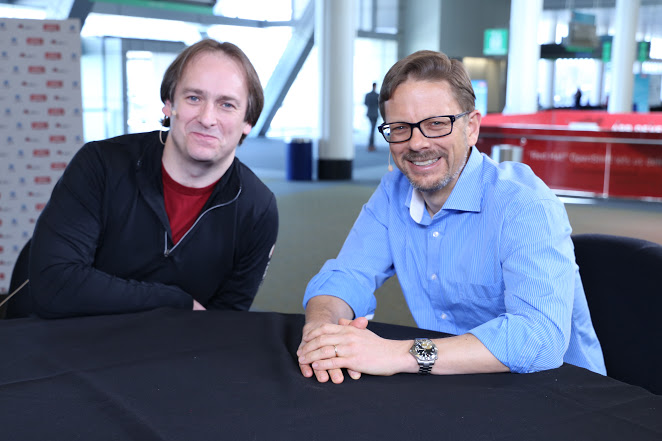 CLOUD
CLOUD
 CLOUD
CLOUD
 CLOUD
CLOUD
Enterprise adoption of containers and microservices continues to grow, driven by increased developer efficiency and support microservices. This type of architecture, however, does not come without challenges. And this week during Red Hat Summit in Boston, Massachusetts, Red Hat Inc. announced OpenShift Application Runtimes to mitigate those obstacles and accelerate a cloud-native environment.
“One of the things that has continued to be an actual challenge, at least a perceived challenge in the minds of would-be microservices architects, is: ‘How do I manage all the stuff?’” said Mike Piech (pictured, right), vice president and general manager of middleware at Red Hat.
As Piech and Mark Little (pictured, left), vice president of engineering at Red Hat, discussed containers and microservices with Stu Miniman (@stu), co-host of theCUBE, SiliconANGLE Media’s mobile live streaming studio, during the Summit, they spoke about the new offering that improves the functionality of runtimes of the application server. (* Disclosure below.)
Following up on building the architecture, Piech explained that Red Hat is addressing these issues with OpenShift Application Runtimes, or RAW (Red Hat OpenShift Application runtimes’ acronym), which will put those runtimes in an OpenShift-native and Kubernetes-native environment.
The goal is to automate much of the orchestration while removing the manual labor of dealing with many pieces involved and simply making it easier for developers to work with microservices.
Red Hat touts its free, end-to-end cloud-native development environment, as the most robust, comprehensive and easy-to-use open, cloud-native application development environment for production workloads in the industry. Some of the challenges come from re-architecting some of the company’s product line to be more “microservice-y” to work well in OpenShift, according to Little. He mentioned that everything the company does, especially with RAW, is with the effort to make the company’s products OpenShift native.
“It is important that we just don’t think about containers; we [also] need to think about orchestration of containers … which is why we focused on OpenShift and we spent a lot of time over the last few years architecting and broadening our abilities in the microservices area,” Little explained.
While Red Hat customers are talking microservices, they are all on different trajectories going down the microservices path, Piech noted. There is not a one-size-fits-all proposition using microservices, and the enterprise is considering certain use cases, workloads and application domains.
Piech believes that the market is moving noticeably faster, and over the past 6 to 12 months the increase is significant.
“We see a natural evolution of microservices. A microservice should be something that does one thing and one thing well in a single unit of deployment,” he concluded.
Watch the complete video interview below, and be sure to check out more of SiliconANGLE’s and theCUBE’s independent editorial coverage of Red Hat Summit 2017. (* Disclosure: Red Hat Inc. sponsored this Red Hat Summit segment on SiliconANGLE Media’s theCUBE. Neither Red Hat nor other sponsors have editorial control over content on theCUBE or SiliconANGLE.)
Support our mission to keep content open and free by engaging with theCUBE community. Join theCUBE’s Alumni Trust Network, where technology leaders connect, share intelligence and create opportunities.
Founded by tech visionaries John Furrier and Dave Vellante, SiliconANGLE Media has built a dynamic ecosystem of industry-leading digital media brands that reach 15+ million elite tech professionals. Our new proprietary theCUBE AI Video Cloud is breaking ground in audience interaction, leveraging theCUBEai.com neural network to help technology companies make data-driven decisions and stay at the forefront of industry conversations.